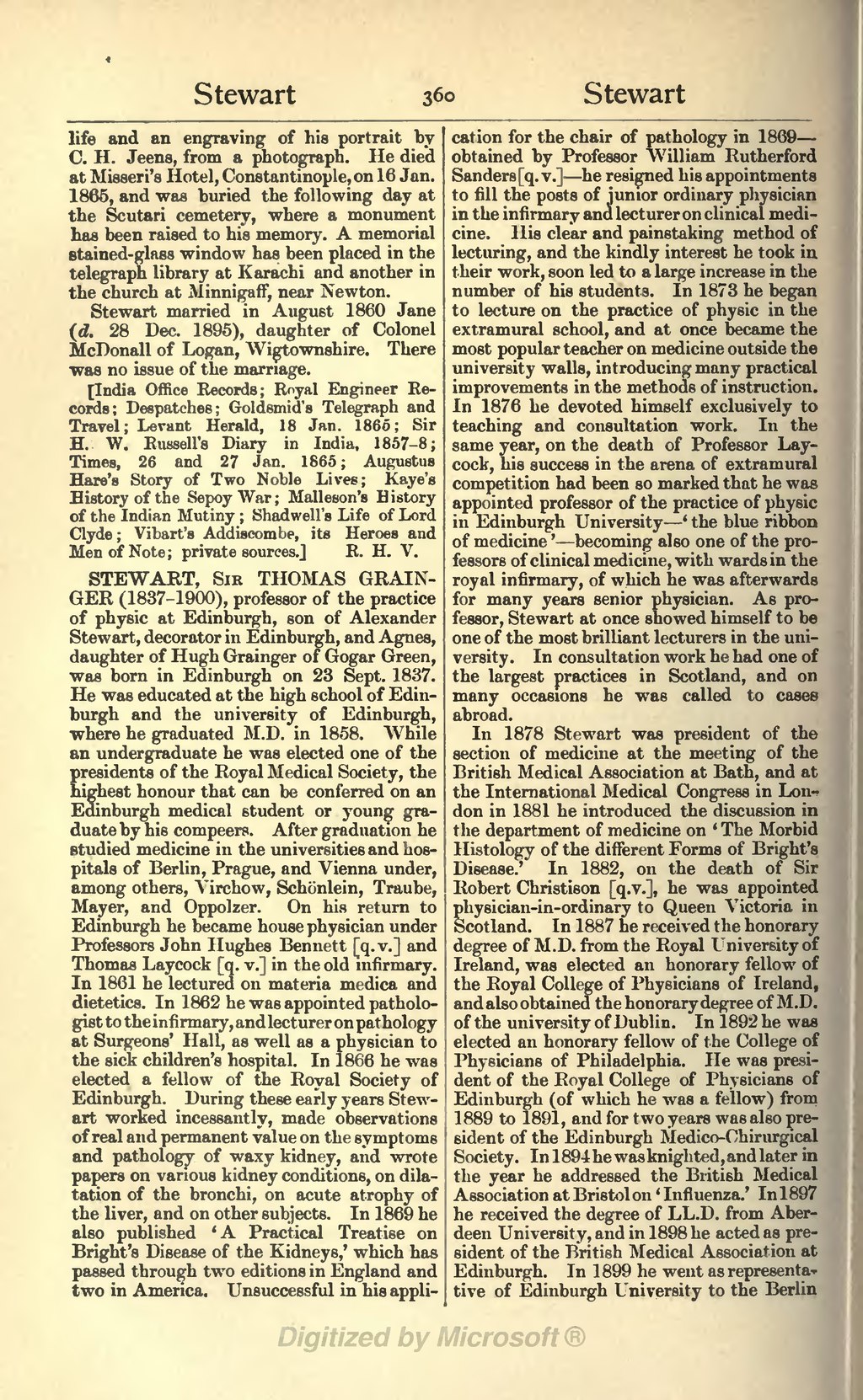life and an engraving of his portrait by C. H. Jeens, from a photograph. He died at Misseri's Hotel, Constantinople, on 16 Jan. 1865, and was buried the following day at the Scutari cemetery, where a monument has been raised to his memory. A memorial stained-glass window has been placed in the telegraph library at Karachi and another in the church at Minnigaff, near Newton.
Stewart married in August 1860 Jane (d. 28 Dec. 1895), daughter of Colonel McDonall of Logan, Wigtownshire. There was no issue of the marriage.
[India Office Records; Royal Engineer Records; Despatches; Goldsmid's Telegraph and Travel; Levant Herald, 18 Jan. 1865; Sir H. W. Russell's Diary in India, 1857-8; Times, 26 and 27 Jan. 1865; Augustus Hare's Story of Two Noble Lives; Kaye's History of the Sepoy War; Malleson's History of the Indian Mutiny; Shadwell's Life of Lord Clyde; Vibart's Addiscombe, its Heroes and Men of Note; private sources.]
STEWART, Sir THOMAS GRAINGER (1837–1900), professor of the practice of physic at Edinburgh, son of Alexander Stewart, decorator in Edinburgh, and Agnes, daughter of Hugh Grainger of Gogar Green, was born in Edinburgh on 23 Sept. 1837. He was educated at the high school of Edinburgh and the university of Edinburgh, where he graduated M.D. in 1858. While an undergraduate he was elected one of the presidents of the Royal Medical Society, the highest honour that can be conferred on an Edinburgh medical student or young graduate by his compeers. After graduation he studied medicine in the universities and hospitals of Berlin, Prague, and Vienna under, among others, Yirchow, Schonlein, Traube, Mayer, and Oppolzer. On his return to Edinburgh he became house physician under Professors John Hughes Bennett [q. v.] and Thomas Laycock [q. v.] in the old infirmary. In 1861 he lectured on materia medica and dietetics. In 1862 he was appointed pathologist to the infirmary, and lecturer on pathology at Surgeons' Hall, as well as a physician to the sick children's hospital. In 1866 he was elected a fellow of the Royal Society of Edinburgh. During these early years Stewart worked incessantly, made observations of real and permanent value on the symptoms and pathology of waxy kidney, and wrote papers on various kidney conditions, on dilatation of the bronchi, on acute atrophy of the liver, and on other subjects. In 1869 he also published 'A Practical Treatise on Bright's Disease of the Kidneys,' which has passed through two editions in England and two in America. Unsuccessful in his application for the chair of pathology in 1869 obtained by ProfessorWilliam Rutherford Sanders [q. v.] he resigned his appointments to fill the posts of junior ordinary physician in the infirmary and lecturer on clinical medicine. His clear and painstaking method of lecturing, and the kindly interest he took in their work, soon led to a large increase in the number of his students. In 1873 he began to lecture on the practice of physic in the extramural school, and at once became the most popular teacher on medicine outside the university walls, introducing many practical improvements in the methods of instruction. In 1876 he devoted himself exclusively to teaching and consultation work. In the same year, on the death of Professor Laycock, his success in the arena of extramural competition had been so marked that he was appointed professor of the practice of physic in Edinburgh University 'the blue ribbon of medicine' becoming also one of the professors of clinical medicine, with wards in the royal infirmary, of which he was afterwards for many years senior physician. As professor, Stewart at once showed himself to be one of the most brilliant lecturers in the university. In consultation work he had one of the largest practices in Scotland, and on many occasions he was called to cases abroad.
In 1878 Stewart was president of the section of medicine at the meeting of the British Medical Association at Bath, and at the International Medical Congress in London in 1881 he introduced the discussion in the department of medicine on 'The Morbid Histology of the different Forms of Bright's Disease.' In 1882, on the death of Sir Robert Christison [q. v.], he was appointed physician-in-ordinary to Queen Victoria in Scotland. In 1887 he received the honorary degree of M.D. from the Royal University of Ireland, was elected an honorary fellow of the Royal College of Physicians of Ireland, and also obtained the honorary degree of M.D. of the university of Dublin. In 1892 he was elected an honorary fellow of the College of Physicians of Philadelphia. He was president of the Royal College of Physicians of Edinburgh (of which he was a fellow) from 1889 to 1891, and for two years was also president of the Edinburgh Medico-Chirurgical Society. In 1894 he was knighted, and later in the year he addressed the British Medical Association at Bristol on 'Influenza.' In 1897 he received the degree of LL.D. from Aberdeen University, and in 1898 he acted as president of the British Medical Association at Edinburgh. In 1899 he went as representative of Edinburgh University to the Berlin
